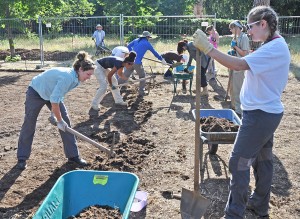Professor leads archaeology expedition
For the past five years, professor of classical art and archaeology John Pollini has led a six-week field archaeology course in Italy. AHIS 325, Roman Archaeological Excavation: Methods and Practice, takes place in Ostia Antica, an ancient port city along the Tiber River.

Students at work · Students in the “Roman Archaeological Excavation: Methods and Practice” course are seen working on-site. – Photo courtesy of John Pollini
This summer, 13 students from a variety of majors joined Pollini to excavate Ostia and explore the sites of ancient Rome and modern Italy. During their first week, the students followed a booklet of instructions that led them through sights in Rome that they had previously seen only in textbooks.
“[The Italian] perception of what is modern is so different from what modern is to us … [the year] 1700 is still modern to them,” said Stella Chung, a junior majoring in communication and political science.
Starting the second week, the students woke up at 6 a.m. each day to catch a train from their apartments in Rome to the dig site. From there, the students were split up into groups based on their interests. Many students had different experiences, but they unanimously agreed that Pollini had the answer to everything.
“He’s really funny and very approachable” said Madalina Nastase, a sophomore majoring in theatre.
When Pollini began teaching art history and classics at USC in 1987, the archaeology department did not yet exist. A childhood trip to Egypt ignited Pollini’s passion for archaeology, but he decided to pursue classics after taking Latin in high school.
Antiquity, the period preceding the Middle Ages, is Pollini’s main interest. He is particularly interested in ancient religion, mythology, narratology, rhetoric and propaganda as well as the interplay between the different fields. In 2012, he published his sixth book, From Republic to Empire: Rhetoric, Religion, and Power in the Visual Culture of Ancient Rome.
Pollini often tells students that antiquity is like looking at “a slice of Swiss cheese with a lot of holes in it.”
“Normally literary sources tend to be by the upper classes, so you’re going to get a specifically aristocratic point of view … but then the archaeological sources tell a different story, they fill in gaps that are missing. … The archaeological evidence also tells us great deal about the common people,” Pollini said.
Consequently, AHIS 325 is about balancing perspectives. Pollini leads the class to expose archaeology majors to field work. The ongoing program, supported by the nonprofit American Institute for Roman Culture, was designed for students with no excavation experience.
The possibility of finding skeletons was a major selling point for Chung, who said she signed up because she wanted to “touch dead things.” Emma Wang, a sophomore majoring in international relations who originally stumbled upon the program through a pamphlet at the Roski School of Fine Arts, helped unearth part of a human jaw and skull. She said that one of the most exciting parts was looking at the stratification in the ground.
“You see [those] layers of dirt, and that’s history right in front of us,” Wang said.
Pollini revealed that this year the class discovered a mausoleum that was possibly reused in the Christian era to bury St. Monica, the mother of City of God author and theologian St. Augustine. The building might also have served as the final resting place of St. Aurea, a local saint. As teams in Rome continue digging, they hope to confirm the identity by next year. This year they also continued to excavate a fourth century A.D. Roman house, where they found early medieval-period fishing equipment that could have been used in commercial fishing activities.
Pollini, who is currently on sabbatical, will be working on a project dealing with late antiquity, from the fourth to seventh century A.D., on the Christian destruction and desecration of images of classic antiquity, a topic on which he has published several articles. On Oct. 29, Pollini will give a lecture on Augustan monuments at the Getty Villa as part of the 2,000th anniversary of Emperor Augustus’ death.
For the students of AHIS 325, the summer taught them skills such as how to draw plans and how to keep a journal. Chung said the dig taught her about teamwork and how to work without egos getting in the way. Wang noted the dig taught her about responsibility.
“If you make a mistake, that mistake is going to stay with the item,” Wang said, “It’s going to be passed down through history, so you know that you have a huge responsibility to document every single thing you do.”

